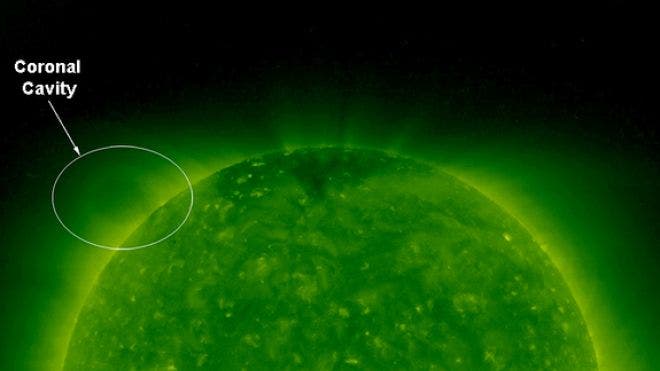From time to time, the sun projects billion-ton clouds of charged particles from its scorching surface, surrounded by a solar atmosphere scientists dub corona, into space. Sometimes, these blasts hit the Earth’s magnetic field with a high potential for wrecking havoc to satellites and communications, and in extreme cases massive electrical power surges. It’s become a sort of priority, thus, for astronomers and other scientists from around the world to study and understand how these blasts form, in order to predict and minimize the damage they might cause.

So far, NASA scientists’ best bet lies on the mysterious cavities in the sun’s outer atmosphere, or corona. Captioned above is this sort of light bulb filament shaped occurrence. The bright structure around and above that light bulb is called a streamer, while the seemingly hollow interior is called a coronal prominence cavity. It’s believed the latter, these cavities, serve as solar launch pads for the huge clouds of hurled plasma known as coronal mass ejections or CMEs.
“We don’t really know what gets these CMEs going,” Terry Kucera, of NASA’s Goddard Space Flight Center in Greenbelt, Md., said in a statement. “So we want to understand their structure before they even erupt, because then we might have a better clue about why it’s erupting and perhaps even get some advance warning on when they will erupt.”
And this is no easy task. Scientists have been studying one particular cavity as part of a series of paper studying its properties, the first two from 2010 and 2011 looked at the shape and density, respectively, and now the latest, published in Sep. 20 edition of The Astrophysical Journal, tackled temperature. By understanding these three aspects of the cavities scientists can better understand the space weather that can disrupt technologies near Earth. Especially during these rather gruesome times, as the sun comes near the end of its 11 year cycle in 2013, time at which CMEs will become more frequent and powerful.
Predicting a coronal mass ejection
Combined, the three studies have these so far to tell – the structure is similar to a croissant, while the inside is filled with a sort of magnetically charged tube, which is the prime driver for its shape. The cavity appears to be about 30 percent less dense than the material surrounding it, and its average temperatures range from 2.5 million to 3 million degrees Fahrenheit (1.4 million to 1.7 degrees Celsius), increasing with distance from the solar surface.
Concerning the latest study from the series, which discuss temperature, the scientists found that the temperature in cavities isn’t all that different form the rest of the matter in the corona, however its a lot more variable. Hopefully with enough data and scientific wisdom, the astronomers can crack down on the code and sequence of events that trigger a CME.
“Our point with all of these research projects into what might seem like side streets, is ultimately to figure out the physics of magnetic fields in the corona,” said Sarah Gibson, a solar scientist at the High Altitude Observatory at the National Center for Atmospheric Research in Boulder, Colo.
“Sometimes these cavities can be stable for days and weeks, but then suddenly erupt into a CME,” added Gibson, who is a co-author on all three studies. “We want to understand how that happens. We’re accessing so much data, so it’s an exciting time — with all these observations, our understanding is coming together to form a consistent story.”



